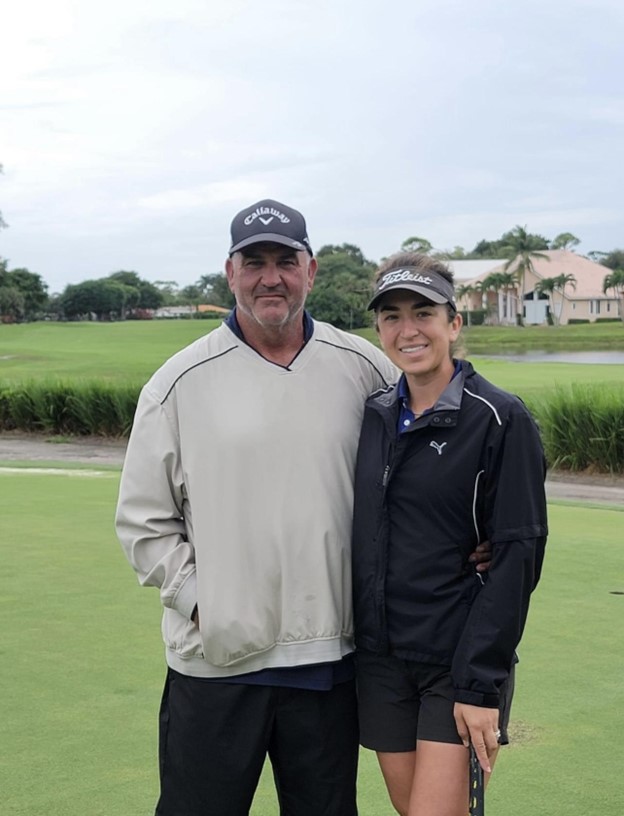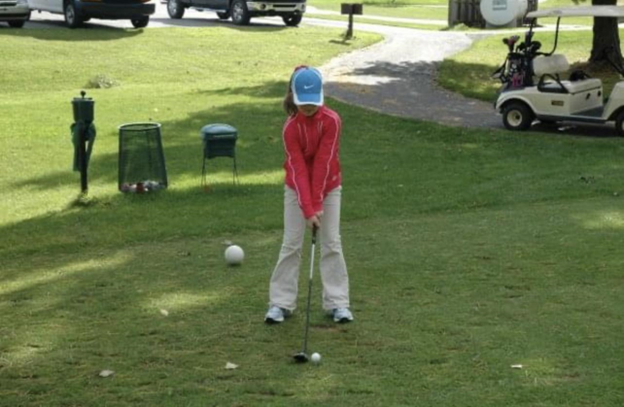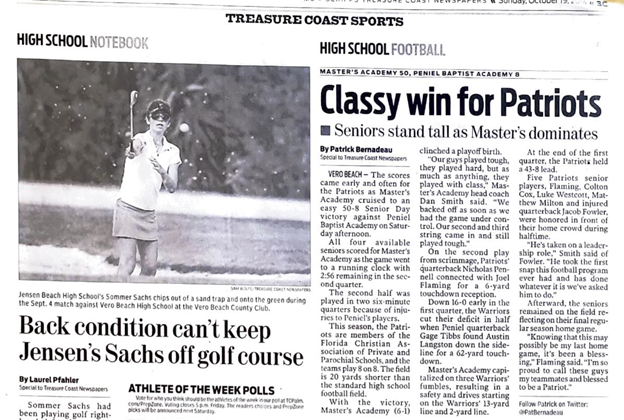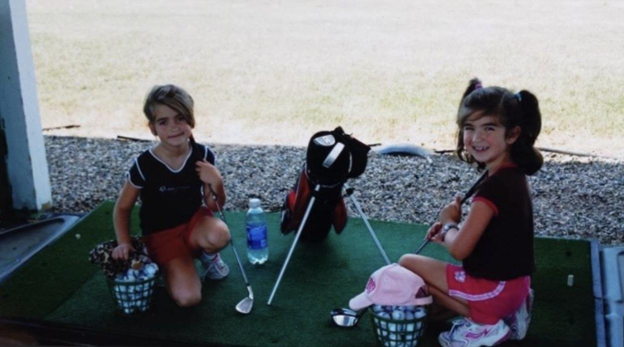

My name is Sommer Sachs. I grew up in a small town in Michigan. I was very involved with sports at a very young age but out of everything that I did golf stuck with me, and I started playing at the age of 5. I played golf year round, even during the harsh winters. We would practice at indoor facilities 3 to 5 days a week.
Eventually, we moved from Michigan to Florida in 2010. One of the reasons we left was to give my sister and I a better chance to be successful playing golf. Having most of the year cold and snowy is not ideal for playing golf. It was a difficult transition to keep playing golf. Our family was relocating to a new home, and for me it was a new school and city. Against all odds, I kept playing at any cost. Most kids would go to church on Sundays, but we would go to the PGA Learning Center and play golf for 12 hours on Sunday.
Around the age of 11, I started competing in US kids tournaments. My dad gave me a 2 weeks notice before my first tournament. One of the courses we played, I ended up in a fairway bunker and I asked my dad, “how I should hit this and he said hit it like a normal shot.” From that point on, I got one lesson from my dad. He said the same hard work and dedication it takes to be successful in golf is the same that applies to life itself.
Outside of school, this was my life. Everyday, even at night, my dad built a golf tee in our backyard. He hung up a net in between 2 trees and put a golf mat down, so we had a good surface to hit off. At night, he would bring a commercial construction light out, so we had no excuse not to practice. Fast-forward to 10 years, we now have a professional golf tee with solar lights in our backyard.
One day at school in P.E class, they had a mandatory wellness test for each student. When they were doing the test, the teacher had found a noticeable curve in my back. My parents and I went to a specialist, and it was confirmed that I have Idiopathic Scoliosis. In my case, there were two curves making it into the shape of an 'S'.
We had an appointment with a doctor, and we were lucky that we caught it so early and start an aggressive treatment so I wouldn't get to a position where it could be life threatening. I was told that I would need a back brace until my growth platelets closed. After they made the mold for the brace, it would be a few weeks till it was ready. When the brace was finally finished, the doctors had me x- rayed again to see if anything had changed. It had already increased 5 degrees.
During this time, I still continued to play golf right handed, and I had to wear a neck brace to prevent my neck from moving when I slept. I didn't wear it for that long. My mom checked in on me when I was sleeping and said it looked like I was barely breathing, so for the majority of the 5 years I only wore the back brace and used pillows to support my neck from moving and increasing the top curve. I had to wear my brace a minimum of 9 hours every night. I was also doing 2 hours of therapy everyday and x rays every 6 months.
The first two years were the most aggressive. The curvature in my back was going up in increments of 5 or more. I would cry every time I left the doctors out of devastation that I wasn't getting any better or the thought that soon enough the surgery would be my fate. It was hard dealing with the pain not just from my back but also the brace I was wearing in order for it to be effective. I had to wear it as tight as it could go. I remember sitting in class and could feel the curvature in my back moving.
A year and half from the first diagnosis, the bottom curve in my back was at 40 degrees, and he told me that I would have to quit golf and get the surgery. My father recommended that I switch to left handed to see if it would reverse my back, so the doctor allowed 6 months to see if it improved. If it didn't, I would have no choice but to have surgery. During these 6 months, we started to play golf as a lefty, and my dad would tell me to mirror him as he swung right handed. It wasn't technical at all in the beginning, I remember the first few months were a struggle. I would beat the ground for hours not being able to get the ball in the air at all.
At the 6th month mark, I've been continuing therapy, weight training, and regular physical fitness. When we went back to the doctors, he told us that my back was now at 8 degrees from the previous 40 degrees. He couldn't believe how much it improved. We realized that when I would swing right handed my back swing controlled the bottom curve and the follow through controlled the top curve.
Now that we had the curve stabilized, it was about maintaining it till the scoliosis wasn't an issue any longer. I did a lot of weight lifting during this time to strengthen my core and back. It was very difficult because of the high level of pain in my back from all of the therapy.
The first year that switched from right to left, I made the varsity team as a freshman. I struggled a lot. It was like starting from nothing but I never gave up. I was so dedicated that my highschool coach would have to come find me with a flashlight at the end of the day. I wanted to stay out as long as I could just to get one more hit in.
While learning how to play left handed, it was a challenge to be a good golfer. It's not a straight line; each golfer has their own unique swing but still fundamentally correct in some way. Scoliosis did not allow my back to turn into the correct position. I had my dad to teach me, but I would think and practice for hours about my swing and certain feelings I would get when I would hit a ball. It really was a back and forth battle for years until I got a good enough swing. It took me about 10 years since I switched to confidently say that I could play on a professional level. The only aspect of my game that was not changed was my putting. I am still putting right handed.
After high school, I had a lot of work to do if I wanted to play for a college team. So for the next 7 months, I trained without a day off. My dad is my coach and since my swing is so unique. I needed him and going far for college wasn't an option, so I reached out to the coach at Palm Beach Atlantic University, a D2 school. I figured my game was good enough to play at a collegiate level, so I contacted the coach and requested a tryout for the team. I made the team and Received a partial scholarship.
I began my collegiate career as a golfer. I was there for 1.5 years actively playing golf before covid hit. I played in one tournament and out of the 2 rounds my lowest was a 75. I was still in college, and I was looking for a woman's tour I could play on.
There were very limited options for me, so I played in a South Florida PGA qualifier. I was the youngest player and the only woman. I had caught the attention of the PGA director, and he informed me that I could play on a tour called Minor League Golf tour. I signed up for one of their tournaments as an Amateur and played alongside the Men. And for the most part, I'm the only woman that consistently plays every week.
To get where I am now, I had to overcome a lot of physical and mental challenges dealing with scoliosis. This disease will stay with me the rest of my life along with the constant pain and limitations of my swing. Ever since I've been diagnosed with scoliosis, I have had to be more dedicated and work twice as hard as everyone else just to get where I am today. I struggled for years before I really understood what I was doing out on the course.
It’s been 10 years since I was first diagnosed with scoliosis, and I’m still pursuing my dream against all the hardship and challenges I’ve had to endure over the years. I’ve had many people doubt me, calling my goals too ambitious and far-fetched, but I’m still going strong, improving everyday against all odds, sacrificing everything to have a chance to pursue my dreams of playing on the LPGA.



